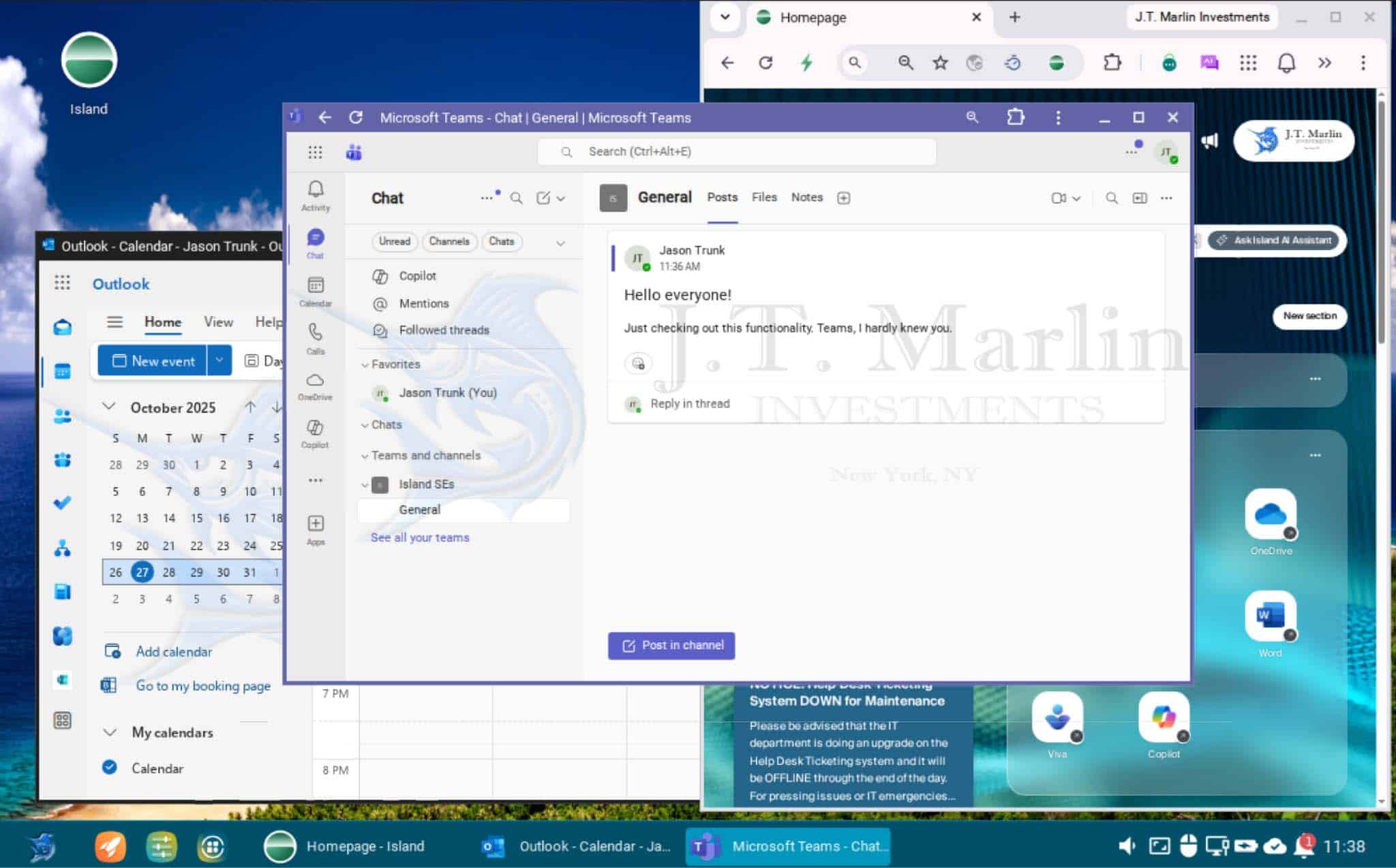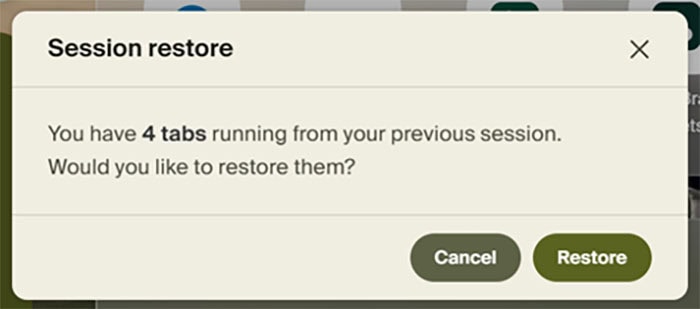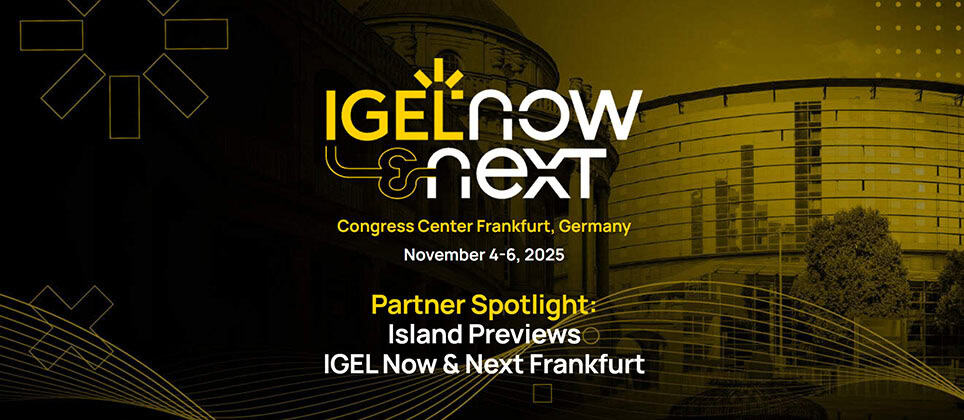IGEL Blog

When Zero Trust Actually Works: Island and IGEL in the Real World
Most zero trust implementations add complexity without fully eliminating security gaps. Except for one — a new approach that builds security directly into the workspace itself.
The Problem We All Know Too Well
Every IT and security leader lives with the same tension: people need to work from anywhere, on any device, while we keep critical data where it belongs.
Zero trust made sense on paper. The principles still hold up. But the implementation has become a mess. Layer after layer of tools that don’t talk to each other. Policies that break workflows. Exceptions that pile up faster than we can manage them.
And here’s the kicker: despite all that complexity, the browser — where most work actually happens — remains a gaping blind spot.
The setup we’ve relied on for years wasn’t built for this.
But a better path is emerging—one that builds zero trust directly into the workspace itself.
By combining the secure-by-design architecture of the Island Enterprise Browser with the immutable, read-only foundation of IGEL OS, organizations finally have the zero-trust workspace they wanted all along – simple, secure, and friction free.
Here’s the full breakdown:
Where It All Falls Apart
Most organizations have achieved something that looks like zero trust: a growing stack of identity tools, CASBs, DLP agents, EDR platforms, and VPNs all bolted onto the workspace. It’s expensive. It’s fragile. And it still leaves gaps everywhere.
The browser is where those gaps hurt most.
Even with a full security stack in place, sensitive data flows in and out of browser sessions with surprising ease. Security teams spend their days chasing false positives instead of enforcing real control. And end users? They’re finding workarounds.
Here’s what that looks like in practice:
- Financial services: Loan officers juggle internal systems and web-based tools that don’t share policies. Locked-down desktops and slow VPNs drive them to personal email and unsanctioned file sharing just to get work done.
- Healthcare: Clinicians rely on cloud-based EHRs and scheduling systems, but constant authentication loops and blocked actions slow down patient care when speed matters most.
- Public sector: Agency employees work with thin budgets and strict compliance mandates, yet still need to support hybrid work and contractors on personal devices.
The pattern is clear: pursuing zero trust has created more friction, more cost, and ironically, more security gaps.
No IT leader wants to rip and replace everything. What we actually need is a way to simplify what we have while closing those gaps — not just in controlled environments, but everywhere work happens.
The Zero-Trust Environment We Always Wanted: Island + IGEL
The Island Enterprise Browser and IGEL OS work together to create something we rarely see: a workspace that’s both genuinely secure and actually simple to manage.

Island brings zero trust into the browser itself — the place where users, applications, and data actually meet. It enforces granular, context-aware controls based on role, device posture, and session context. What users can access, copy, download, or share is governed in real time. Sensitive information stays protected, even on untrusted networks or devices.
IGEL OS secures the foundation. Its Linux-based, read-only architecture means devices boot clean every single time. No local data persistence. No configuration drift. No tampering. Everything is centrally managed, and every reboot restores a known-good state.
Together, they deliver a workspace that’s:
- Secure by default — Every session runs in a controlled environment, from device to browser
- Centrally managed — No local installs, no configuration sprawl, one console for everything
- Frictionless for users — Workflows stay fast and familiar; security operates invisibly
How It Actually Works
Traditional zero trust sits at the network or identity layer. That leaves blind spots at the edges — right where users interact with data.
Island and IGEL extend zero trust into the workspace itself.
Island: Zero Trust Inside the Browser
Island transforms the browser into a fully governed workspace. Every user action — downloads, clipboard use, screenshots, printing — can be controlled, monitored, and adapted in real time. Policies follow users wherever they work, keeping sensitive data protected regardless of device or location.
IGEL: Immutable and Managed at the Edge
IGEL provides a hardened OS that boots pristine every time. No local data. No rogue applications. No drift. IT manages thousands of endpoints from a single console, applying updates and policies instantly and consistently.
Island governs what happens inside the workspace. IGEL governs the environment running it. The result: continuous verification, complete visibility, and true zero trust — without the complexity we’ve come to expect.
What This Looks Like in the Real World
This isn’t a concept. Organizations are using this combination today to secure work at scale.
Beyond VDI: Many IGEL deployments today launch the client to a VDI session, which can be a slow and frustrating experience. With Island, it’s the same IGEL endpoint hardware – but a fundamentally different experience. Users log in instantly to a purpose-built workspace with all their applications available in a single click. Island runs natively on IGEL devices, leveraging local processing power to deliver a fast, responsive experience to corporate resources – without the VDI overhead.
Healthcare Mobility: A hospital network uses Island’s session restore on IGEL – managed carts and workstations throughout their facilities. Clinicians move constantly – from patient rooms to nurses’ stations to procedure areas. Island restores open apps and data exactly as it was, no matter which device they move to. No re-authenticating. No hunting for where they left off. They pick up mid-workflow and keep moving. All while IGEL ensures every endpoint stays locked down and compliant.

Remote Work: A global bank uses IGEL endpoints with Island to enable secure access for remote loan officers. They log into the Island Enterprise Browser on IGEL-managed devices, with every action monitored and controlled. Island’s native Data Loss Protection (DLP) capabilities, including “exact data matching” ensures no bank data is at risk of escaping the workspace. Zero data leakage. Zero slowdown.
BYOD Done Right: A public health agency equips contractors with USB-bootable IGEL workspaces running Island. The OS ensures devices stay clean and compliant. Island ensures all data stays within sanctioned apps. It’s a secure BYOD model that needs no MDM or endpoint agents.
Call Centers: In financial and insurance environments, Island and IGEL eliminate the friction of desktop lockdowns. Agents access cloud systems through Island on IGEL devices. Customer data never leaves the environment. Workflows stay smooth and responsive.
What Zero Trust Should Have Been All Along
For years, we’ve treated zero trust as an architectural puzzle — a collection of frameworks and tools we layer on top of what we already have.
Island and IGEL show it can be simpler: a workspace that’s secure by design and frictionless by nature.
When zero trust is built into both the browser and the device, security stops being a separate process. It becomes the environment itself.
Work happens anywhere, safely. Users stay productive. Complexity gives way to clarity.
This isn’t a future vision. It’s what the enterprise workspace can look like today.
With Island and IGEL, zero trust isn’t another layer of control. It’s just how the workspace works.
Join the breakout session Zero Trust in Practice with the Island Enterprise Browser hosted by Michael Mauch from Island at Now & Next November 4-6, 2025


